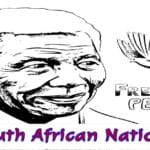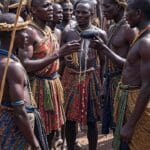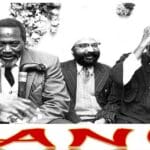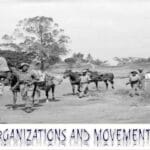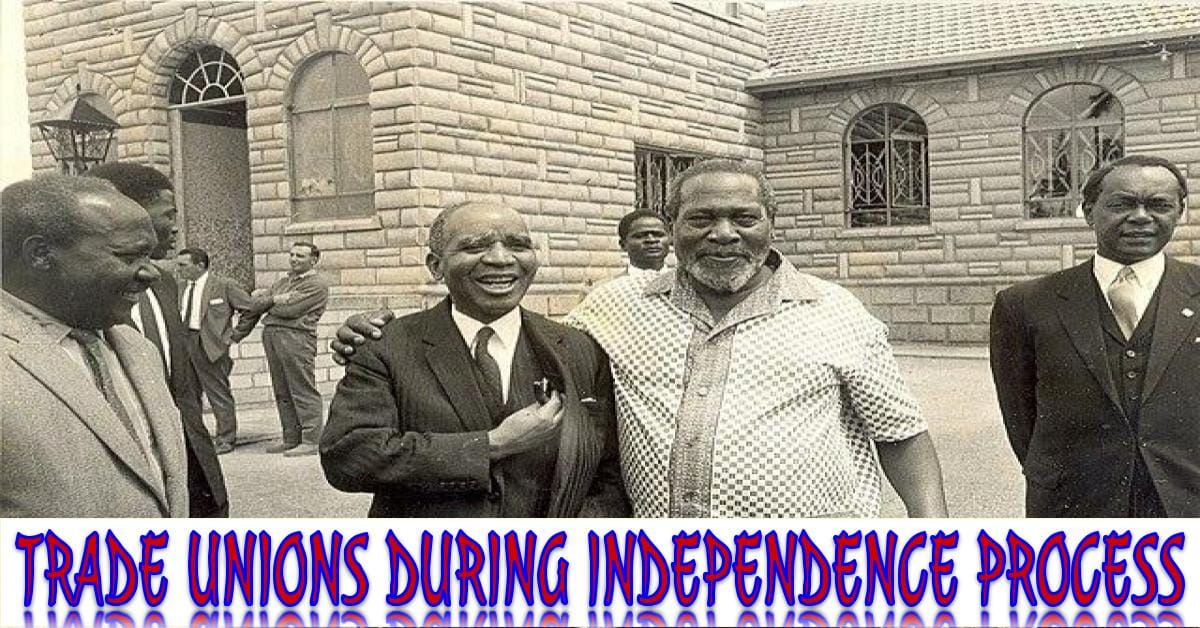📜 THE MAU-MAU REBELLION (1951-1960) ⚔️
“Let the white man go back to Europe and Africans regain independence”
🔍 Introduction
Mau-Mau was an abbreviation standing for “Mzungu Arudi Ulaya, Mwafirika Apate Uhuru” (Let the white man go back to Europe and the Africans regain Independence). The movement was also known as:
- 🏴 The ‘Land and Freedom Army’
- 👥 The Anake-a-Forty (The Forty Group)
In the late 1940s, the banned Kikuyu Central Association (KCA) began preparing for civil disobedience to protest land issues, binding members through powerful oath rituals.
⚡ The Oathing System
Purpose
- Cultural symbol of Kikuyu solidarity
- Bound men, women and children in loyalty
- Instilled courage and unity against colonialism
Controversial Aspects
- Rumors of cannibalism and ritual zoophilia
- Decorated ritual places with intestines/goat eyes
- Oaths included promises to kill settlers
British response: Made taking Mau Mau oath a capital offense and forced suspects to take ‘cleansing oaths’
🔥 Causes of the Mau-Mau Rebellion
🗺️ Land Dispossession
By 1948: 1.25 million Kikuyu restricted to 2,000 sq miles vs 30,000 settlers occupying 12,000 sq miles of fertile land.
💼 Economic Grievances
Unemployment of WWII veterans, Asian trade monopolies, restricted cash crop farming, and forced labor.
🎭 Racial Discrimination
Best hotels, schools, and fertile lands reserved for whites. Africans considered inferior.
🗳️ Political Exclusion
Africans excluded from decision-making. Political parties banned and leaders detained.
📜 Cultural Threats
Missionaries opposed female circumcision and traditional views (e.g., twins).
🎖️ WWII Influence
Ex-servicemen learned European weaknesses and military tactics.
⏳ Course of the Uprising
1949-1951: Organization Phase
Trade unions formed EATUC. KAU radicals created secret Central Committee (Muhimu) to coordinate oaths and form armed squads.
1952: Escalation
Oct 1: Assassination of Nairobi councillor Tom Mbotela
Oct 3: First European victim killed
Oct 9: Senior Chief Waruhiu assassinated
Oct 20: State of Emergency declared
1953: Major Events
Jan 24: Ruck family murdered
March: Lari massacre (170 loyalists killed)
May: Kikuyu Home Guard established
June: General Erskine arrives with 20,000 troops
1954: Crackdown
April: Operation Anvil in Nairobi
June: Compulsory villagization begins
77,000 Kikuyu in concentration camps
1956: Endgame
Oct 21: Dedan Kimathi captured (last leader)
Hanged in early 1957
Emergency lasted until January 1960
👥 Key Leaders
- 🌟 Dedan Kimathi (Aberdare forest)
- 🌟 Waruhiu Itote “General China” (Mt. Kenya)
- 🌟 Stanley Mathenge
- 🌟 General Ndung’u Gicheru
- 🌟 General Mwariama
- 🌟 General Matenjagwo
🌍 Mau-Mau by Other Communities
- Kamba: Railway sabotage by Kamba Central Committee (April 1953)
- Maasai: Rebel bands in Narok district
- Maragoli: Chief Mukudi of Bunyore associated with movement
- Kipsigis (Kalenjin), Luo: Also participated
✅ Success Factors
- Oathing created unity and courage
- Effective guerrilla tactics
- Civilian support (food, spying)
- Strong leadership (Kimathi, China)
- Natural forest hideouts
- Access to weapons (homemade guns, pangas)
❌ Challenges Faced
- Lacked transport/communication
- Harsh weather in forests
- Wild animal attacks
- Inferior weaponry
- British brutality
- Internal divisions
- Infiltration by spies (pseudo-gangs)
- Poor coordination
- Arrest of key leaders
📌 Results of the Mau-Mau Uprising
💀 Human Cost
11,503 Kenyans, 1,800 civilians, 32 British civilians killed. Widespread torture and abuse by British forces.
🏚️ Property Destruction
Villages, houses and crops burned down. Kikuyu, Meru and Embu relocated from Nairobi.
🗳️ Political Impact
Sped up independence. Reduced settler influence. KAU banned (1952).
🏡 Villagization
1,077,500 Kikuyu concentrated into 854 “villages” by October 1955.
🌱 Swynnerton Plan
Land reform (1954) creating family holdings with title deeds for progressive farmers.
⚖️ Legacy
Bitter divisions among Kikuyu between loyalists and Mau Mau. International attention on colonial abuses.
🌄 The Swynnerton Plan (1954)
Response to land grievances that refused direct concessions to Mau Mau demands. Created by Roger Swynnerton (Assistant Director of Agriculture).
📋 Key Recommendations:
- ✔️ Survey/enclosure of African land
- ✔️ Title deeds for progressive farmers
- ✔️ New agricultural methods allowed
- ✔️ Credit access for select Africans
- ✔️ Individual land ownership permitted
- ✔️ Cash crop growing rights
Goal: Create self-sufficient family holdings generating cash income through alternate husbandry.
UNLOCKED SELF-ASSESSMENT TEST ON TOPIC
Oops! Unlock More Access Rights:
If you find that you are not subscribed, consider upgrading your account or subscribing to the necessary plan to gain access.
Related Tutorials
- Key South African Nationalists and the Liberation StruggleSouth African Nationalists Key South African Nationalists and the Liberation Struggle Prominent Nationalist Leaders Nelson…
- Key South African Nationalists🧭 Table of Contents Key South African Nationalists 1. Key Figures of South African Nationalism Nelson…
- Nationalism in South Africa: Self Assessment TestUpgrade or Subscribe Oops! Unlock More Access Rights: If you find that you are not…
- Nationalism in South Africa🌍 Nationalism in South Africa The development of nationalism in South Africa was uniquely complex…
- Mozambique Nationalism: Self-Assessment TestMozambique Nationalism Quiz Mozambique Nationalism Quiz 🇲🇿 Test your knowledge about Mozambique’s journey to independence….
- Nationalism in Mozambique: The Long Road to Independence🇲🇿 Nationalism in Mozambique: The Long Road to Independence Mozambique was among the last African…
- Unlock Self-Assessment Test: EMERGENCE AND GROWTH OF NATIONALISM IN AFRICAUpgrade or Subscribe Oops! Unlock More Access Rights: If you find that you are not…
- EMERGENCE AND GROWTH OF NATIONALISM IN AFRICA🌍 EMERGENCE AND GROWTH OF NATIONALISM IN AFRICA Key Factors for the Rise of Nationalism…
- Self-Assessment Test: Constitutional Changes in Kenya Leading to IndependenceKenya Constitutional Changes Self-Assessment Kenya Constitutional Changes Self-Assessment Test your knowledge about Kenya’s journey to…
- Constitutional Changes in Kenya Leading to Independence📜 Constitutional Changes Leading to Kenyan Independence 🇰🇪 The Journey to African Representation in the…
- Women in Kenya’s Independence Struggle👩💼 Women in Kenya’s Independence Struggle A Comprehensive Tutorial on Female Heroes of Freedom 🌟…
- Kenya Federation of Labour🇰🇪 Kenya Federation of Labour 🏛️ History, Achievements, and Role in Kenya’s Independence Struggle 📜…
- The Trade-Union Movement in Kenya🇰🇪 The Trade-Union Movement in Kenya 📜 A journey through the history of workers’ rights…
- Kenya African Democratic Union (KADU)🇰🇪 Kenya African Democratic Union (KADU) 🇰🇪 Safeguarding Minority Interests in Kenya’s Independence Struggle 1960-1964…
- African People’s Party (APP)🏛️ African People’s Party (APP) 📚 Kenya’s Political History Tutorial 1 📖 Introduction & Overview…

